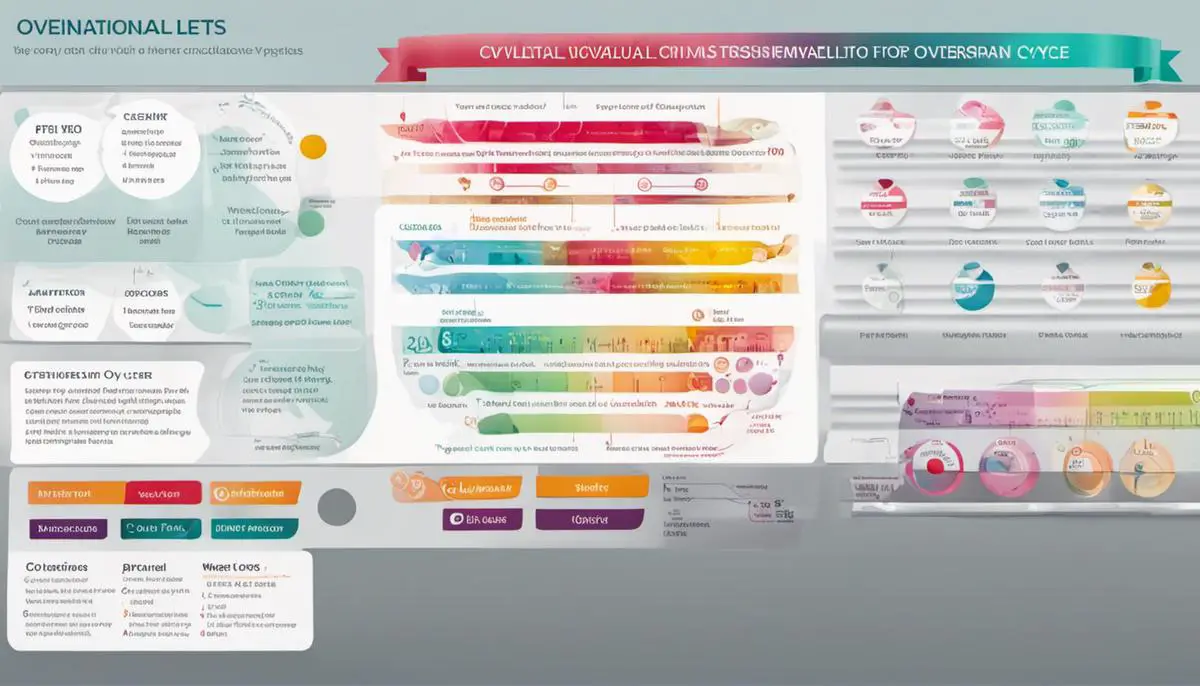Understanding the human reproductive system, specifically ovulation, is vital for those trying to become parents. This process is regulated by various hormones, with the Luteinizing Hormone (LH) playing a critical role in initiating ovulation. A positive ovulation test, primarily detecting LH surge, hints at the impending ovulation, making these tests invaluable tools for individuals planning for a baby. This essay sheds light upon the ovulation process, the role of hormones, and how ovulation tests operate. It also explains what to expect after receiving a positive ovulation test result, and how individual factors could possibly influence the timeline of ovulation.
Ovulation Basics
Understanding the Menstrual Cycle
The menstrual cycle is regulated by the body’s endocrine system and involves the ovaries and the uterus. This cycle, ranging from 21 to 35 days in healthy adult women, prepares the body for potential pregnancy. In the cycle, the first half is known as the follicular phase, and the second half is the luteal phase. The cycle begins on the first day of menstrual bleeding (day 1), which is the starting point of the follicular phase.
Role of Hormones in the Menstrual Cycle
The menstrual cycle is governed by different hormones. The follicular phase initiates with low levels of estrogen and progesterone. In response, the hypothalamus produces gonadotropin-releasing hormone (GnRH), which induces the pituitary gland to release follicle-stimulating hormone (FSH). FSH drives the maturation of follicles in the ovaries, each containing an egg. The dominant follicle produces estrogen, thickening the uterine lining or endometrium, preparing for potential pregnancy.
The Role of Luteinizing Hormone
The sharp rise in estrogen from the dominant follicle triggers a surge in luteinizing hormone (LH) from the pituitary gland. This is often called the ‘LH surge’. The LH surge plays a pivotal role in triggering ovulation, usually occurring about 24 to 48 hours before ovulation. It prompts the dominant follicle to release its egg from the ovary into the fallopian tube — this event is ovulation.
From LH Surge to a Positive Ovulation Test
An ovulation test, also known as an ovulation predictor kit (OPK), measures levels of LH in the urine. As LH surges about a day or two before ovulation, a positive ovulation test indicates that you are likely in your most fertile window. The egg released during ovulation can be fertilized for about 12 to 24 hours after it’s released. Therefore, having sexual intercourse within 24 to 36 hours after a positive ovulation test could increase your chances of becoming pregnant.
In summary, a positive ovulation test typically means that you will likely ovulate in the next 24 to 36 hours. However, this is not exact, and actual timing may depend on individual variations in the menstrual cycle and hormone levels. Consulting a healthcare professional is best for personalized fertility advice.

Ovulation Tests
Understanding Ovulation Tests
Ovulation tests, also known as ovulation predictor kits (OPKs), are used to detect a surge in the luteinizing hormone (LH) that occurs before ovulation. These tests function similarly to home pregnancy tests by checking for particular hormones in your urine. In this case, they’re looking for a rise in LH, which can signal that you’re about to ovulate. Normally, LH levels start to rise about 24 to 36 hours before you begin to ovulate—this surge is what the ovulation test measures.How to Use Ovulation Tests
When using an ovulation test, follow the manufacturer’s instructions closely. Generally, the process begins with gathering a urine sample. This can be done by either urinating on the test stick or dipping the stick into a cup of urine. After a few minutes, the results should be visible. A change in the color or appearance of a line or symbol typically indicates a positive result, meaning the LH surge has been detected.Closely Monitoring Your Cycle
To increase the chances of capturing the surge in the luteinizing hormone, you should start testing a few days before your expected ovulation date. This date can be estimated based on your menstrual cycle. If your cycle is regular (about 28 days long), you should start testing on about day 11. If your cycle is irregular or longer than 28 days, begin testing a few days earlier.Recognizing a Positive Ovulation Test and Timing Ovulation
A positive result on an ovulation test, indicating a high level of LH, suggests that ovulation is likely to occur within the next 12 to 36 hours. This is considered the most fertile time of your cycle and the best time to try to conceive. Remember that a positive test doesn’t guarantee ovulation, it only indicates there is a surge in LH level. Actual ovulation can only be confirmed by an ultrasound or other medical tests.In some cases, women may have a sharp rise in LH but not ovulate or ovulate without an LH surge, which can make predicting ovulation challenging. Because of this, it isn’t recommended to use ovulation tests as a sole method of fertility tracking. Combining them with other strategies, such as monitoring basal body temperature and changes in cervical mucus, can provide a more accurate understanding of your fertile window.
Remember, the goal of using ovulation tests is to predict when you will ovulate. If you’re trying to conceive, plan to have sex during the 24 to 36 hour window immediately after the test turns positive for the best chances of conception.

The Science Behind Positive Ovulation Tests
Understanding Ovulation Tests
Ovulation tests are tools used by women to track their menstrual cycle. These tests detect hormones in the urine, specifically luteinizing hormone (LH). The level of LH in the body spikes about 24 to 36 hours prior to ovulation, which is the release of an egg from the ovaries. This surge in LH triggers ovulation and is usually the body’s natural way of saying it’s the prime time for fertilization.
Positive Ovulation Test: An Indication of LH Surge
A positive ovulation test is an indicator of an LH surge. The test displays two line markings, if the test line is as dark or darker than the control line, it is considered positive. This implies that the body is preparing for ovulation. Some digital ovulation tests might indicate a positive result with a smiley face or other symbol.
Timing of Ovulation Post Positive Test
According to research, most women usually ovulate 24 to 36 hours after a positive ovulation test. This period is often referred to as the ‘fertility window’ or the best time to try for a baby. That means once the ovulation test is positive, sexual intercourse within the next 24 to 48 hours has the highest probability of resulting in a pregnancy.
Fluctuations in Ovulation Timing
However, it’s important to note that the timing of ovulation can vary among women, and even from cycle to cycle within the same woman. Factors such as stress, diet, or illness can influence the timing of ovulation and may interfere with accurate predictions.
Utilizing Ovulation Tests for Pregnancy Planning
Many women use ovulation tests as part of their family planning methods. Having regular unprotected sex throughout the menstrual cycle will give a woman the best chance of getting pregnant. However, understanding the timing of ovulation can help couples plan intercourse for the time when conception is most likely to occur. Regardless of whether a woman is trying to conceive or not, a positive ovulation test is a valuable tool for understanding her menstrual cycle.
Consultation with Healthcare Professional
When using ovulation tests, it’s always a good idea to consult with a healthcare professional. This is particularly critical for women with irregular periods or those who have been trying to conceive for a long time without success. An expert can guide and provide a comprehensive perspective on the use and interpretation of ovulation tests.

Interindividual Variability in Ovulation
Understanding Ovulation and Ovulation Tests
Ovulation refers to the release of a mature egg from the ovary, usually occurring around the middle of the menstrual cycle. It’s the time when a woman is most fertile and the best time to try to conceive. An ovulation test, also known as an ovulation predictor kit, measures the level of luteinizing hormone (LH) in the urine. This hormone surges right before ovulation. The result of the test is positive when this surge is detected.
Variability in Time between Positive Test and Ovulation
According to various studies, the average time frame between a positive ovulation test and actual ovulation typically ranges from 24 to 36 hours. However, there are considerable interindividual variations. Some women may ovulate as soon as 12 hours after a positive test, while others may not ovulate until 48 hours later.
Factors Affecting Time of Ovulation after Positive Test
Numerous factors can influence the time from a positive ovulation test to actual ovulation. For instance, age plays a significant role, as fertility and ovulation patterns change as women age. Those in their late 30s or early 40s may experience an earlier or later ovulation compared to younger women.
Individual health and medical conditions can also influence ovulation. Conditions such as polycystic ovary syndrome (PCOS), obesity, and chronic illnesses can potentially disrupt or even prevent ovulation. Moreover, lifestyle factors like stress, diet, and sleep may also play a role.
Use of Ovulation Tests for Conception Plans
Given the interindividual variability in ovulation, it is essential to use ovulation tests in the context of a broader understanding of one’s menstrual cycle. Combining symptom tracking, basal body temperature monitoring, cervical mucus analysis, and other fertility indicators can give a more accurate prediction of ovulation.
Based on the variability, once a positive test is recorded, it is suggested to plan intercourse for the next few days to increase the chance of conception. It’s also important to keep in mind that ovulation tests, while helpful, are not 100% accurate and do not guarantee conception.
The Importance of Medical Consultation
Ultimately, while recognizing interindividual variability in ovulation and taking proactive measures can help, it is essential to consult with a healthcare provider or fertility specialist for thorough analysis and advice. They can provide invaluable guidance on fertility, explain in detail the variations in ovulation, and suggest customized methods to identify and predict ovulation based on personal circumstances and health factors.

Understanding your body’s rhythm and fertility pattern is crucial, especially when planning for a pregnancy. Ovulation tests, detecting the surge of the Luteinizing hormone, mark an imminent phase of ovulation within 24 to 36 hours. However, factors such as physical health, age, and overall condition could influence each woman’s timeline, adding a layer of individual variability. Hence, it’s important to bear in mind that while these tests are generally reliable indicators of ovulation, they aren’t foolproof, and individual differences should be considered for an accurate exploration of each woman’s unique fertility journey.
